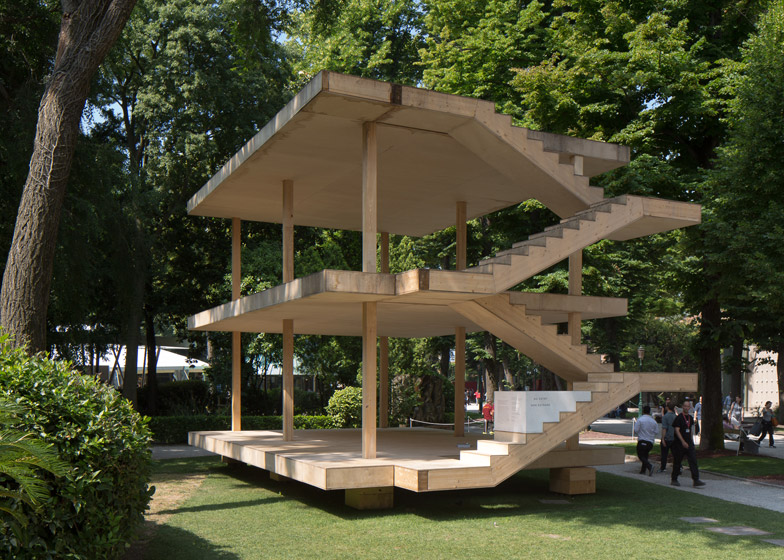Venice Architecture Biennale 2014: German architect Valentin Bontjes van Beek and students from the Architectural Association in London have built a full-size model of Le Corbusier's seminal Maison Dom-ino in the Giardini of the Venice Biennale (photos by Luke Hayes).
First conceived by Le Corbusier in 1914 as a prototype for mass-produced European housing, the minimal design for Maison Dom-ino has become one of the most recognisable images of 20th-century architecture.
One hundred years on, its design principles still form the basis of many architectural projects. The Architectural Association (AA) wanted to celebrate the concept's centenary by creating a year-long programme of events, starting with the construction of a 1:1 model in Venice.
"As a project Dom-Ino distils modern architecture to a set of guiding, abstract and idealised principles. This is a key reason why the 'afterlife' of Dom-ino can still be seen and felt today, a hundred years later on," said AA school director Brett Steele, who commissioned the project.
Located outside the Central Pavilion, the One-to-One Dom-ino was put together by VBVB Studio principal Valentin Bontjes van Beek and AA School students Joshua Penk, Sreerag Palangat Veetil and Thomas Weaver, using Le Corbusier's system B concept.
The structure was first conceived in concrete and steel, but the AA team worked with engineer Jürg Stauffer to create the horizontal floor slabs, slim pilotis and zigzagging staircase from engineered timber.
This allows the project to be flat packed and transported to different locations. After the biennale, it will travel to London then Tokyo as part of the Happy Birthday Dom-ino programme.
"This initial installation will remind visitors not only of modern architecture's most foundational project, but of an architectural instinct made even more apparent today than it was at the time of its original conception; namely that architecture always operates in the space created by a contrast between architecture as already known, and what it might yet become," said Steele.
One-to-One Dom-ino will remain in the Giardini until November. Other exhibitions nearby include the Golden Lion-winning Korean Pavilion and the German Pavilion, which features a replica of a historic building.
Follow Dezeen's coverage of the Venice Architecture Biennale »
Photography is by Luke Hayes.
Here's the full statement from Brett Steele:
One-to-One Dom-Ino
The Maison Dom-Ino was designed by Le Corbusier in 1914 as a housing prototype that would address a Europe-wide housing shortage in the years leading up to the Great War. The system itself never saw widespread production by either the architect or his European contemporaries in the form it was initially conceived. Instead, the unbuilt imagery and generalised design principles embodied in Maison Dom-Ino became the most recognisable – the most fundamental – project of twentieth-century architecture. As a project Dom-Ino distils modern architecture to a set of guiding, abstract and idealised principles. This is a key reason why the 'afterlife' of Dom-Ino can still be seen and felt today, a hundred years later on.
This reconstruction of Le Corbusier's original design is part of that afterlife. It has been made in the form of a 1:1 working model of system 'B' (of the three Le Corbusier originally developed). The original construction system for Dom-ino consisted of horizontal slabs, an integral stairway and slender pilotis, which together reduce modern building to its bare minimum – a concrete structural frame. This 2014 reconstruction replaces the steel and concrete with a twenty-first-century building technology, engineered timber (GSA-Technology). With the help of Bern-based engineer Jürg Stauffer (Neue Holzbau and Just Swiss), this new model follows three of the core principles of the original system: prefabricated elements assembled on site; provision for a locally sourced enclosure or cladding; and the assembly of a unit that can be multiplied horizontally or vertically, as if a domino piece.
This building (of the twentieth-century's most iconic modern architectural drawing) by the AA School for the 2014 Venice Architecture Biennale is the first part of 'Happy Birthday Dom-Ino' – a year-long celebration of the project's centennial. Built as a transportable, flat-pack installation, this 1:1 model will travel from Venice to London, Tokyo and other cities worldwide. In this mobile form, Dom-Ino 2014 offers a demonstration of the project's other fundamental expectation: that modern architectural principles are (and remain) a project for the entire world, for architecture, cities and people everywhere.
This initial installation, in front of the Italia Pavilion at the centre of the biennale, will remind visitors not only of modern architecture's most foundational project, but of an architectural instinct made even more apparent today than it was at the time of its original conception; namely that architecture always operates in the space created by a contrast between architecture as already known, and what it might yet become.
The Architectural Association School of Architecture is grateful for the generous support, advice and assistance of many individuals who have made this project possible.
Original Design: Le Corbusier, 1914, with thanks to the Fondation Le Corbusier, Paris
Reconstruction Commissioned by: Brett Steele (Director, AA School)
Project Architect: Valentin Bontjes van Beek (vbvb studio)
Project Collaboration: Joshua Penk, Sreerag Palangat Veetil (drawings & models), Thomas Weaver
Structural Engineering: Juerg Stauffer (Just SWISS)
Fabrication: Neue Holzbau AG
Assembly Venice: AA Exhibitions
Owner/Client: AA School of Architecture, London
Sponsorship & Support: Just Swiss/Neue Holzbau

